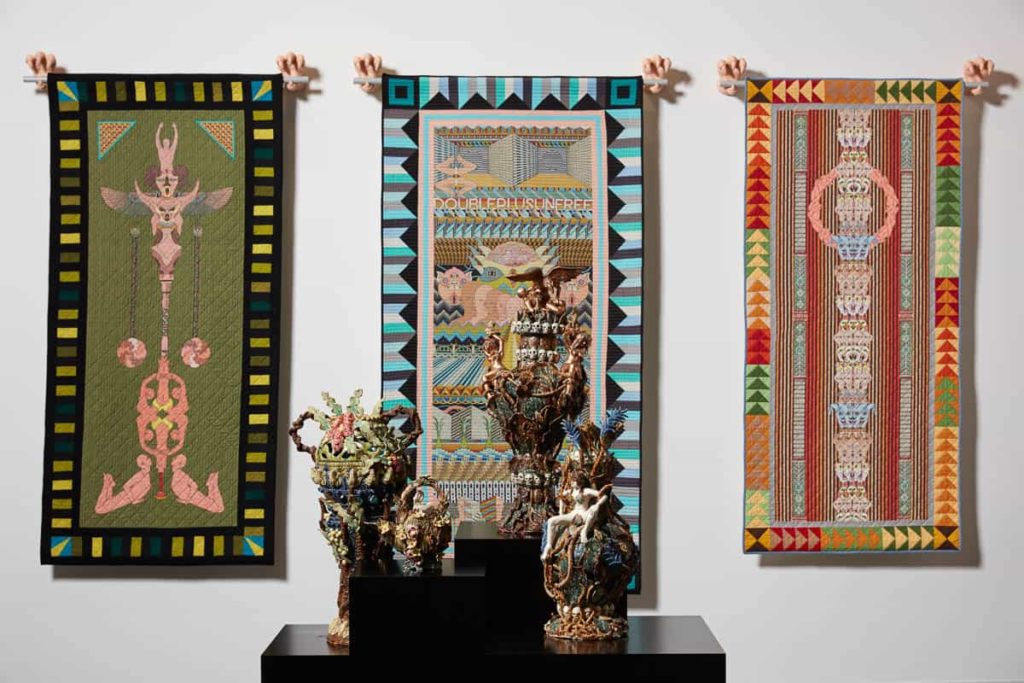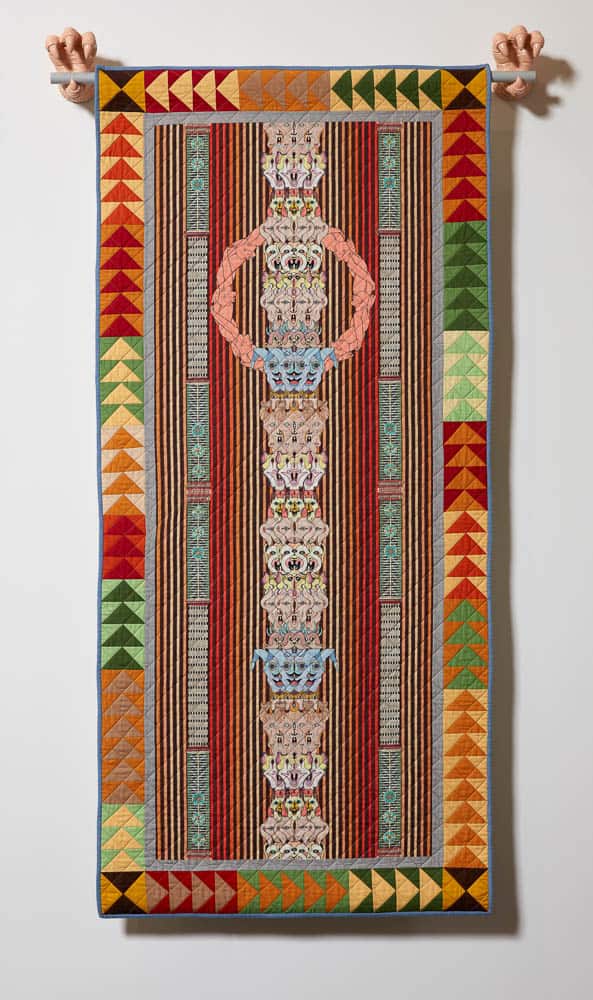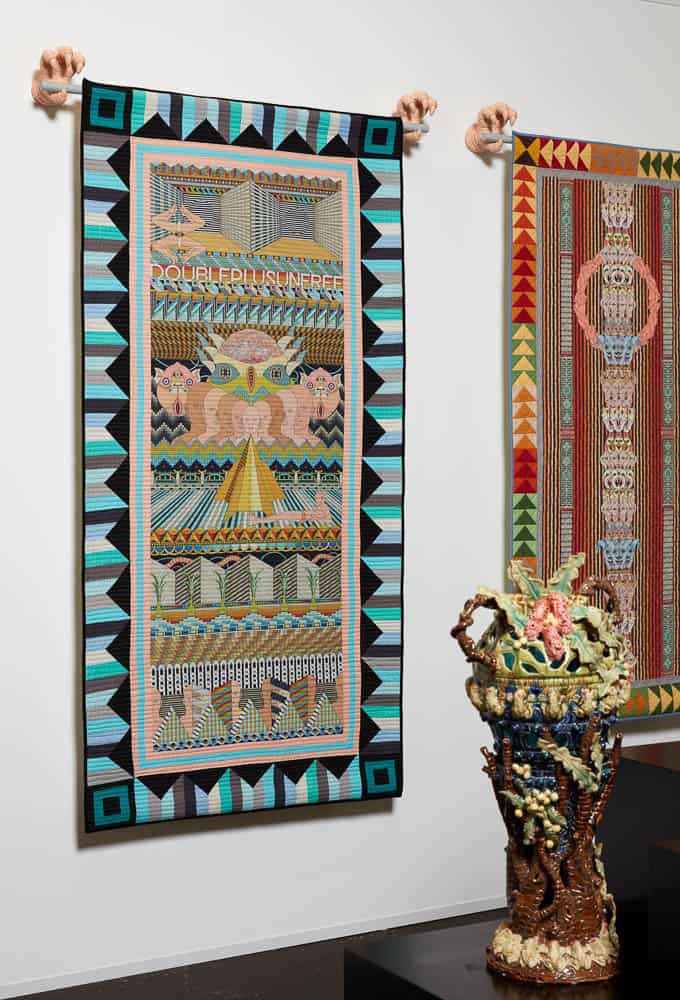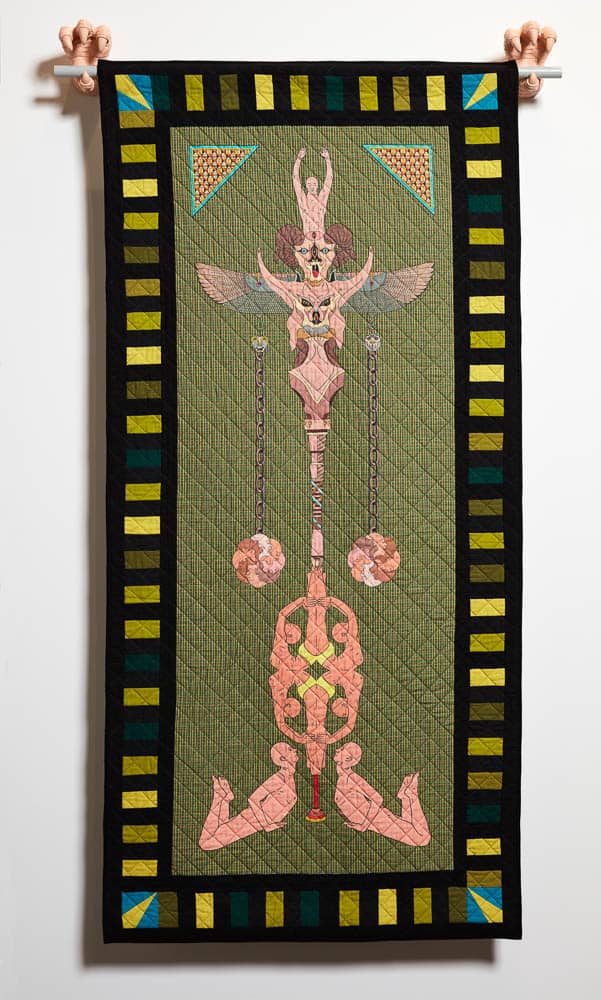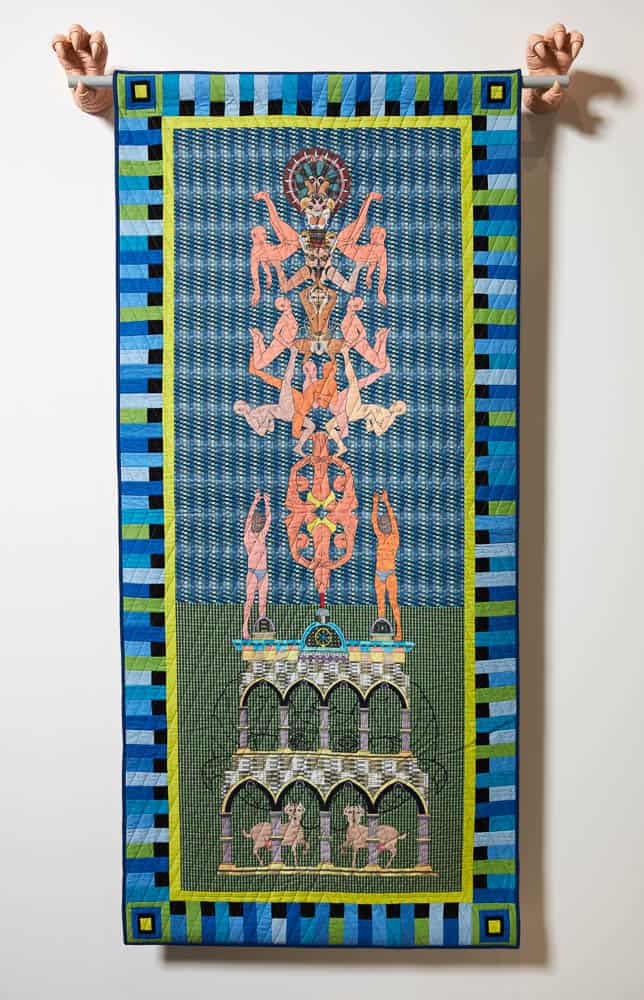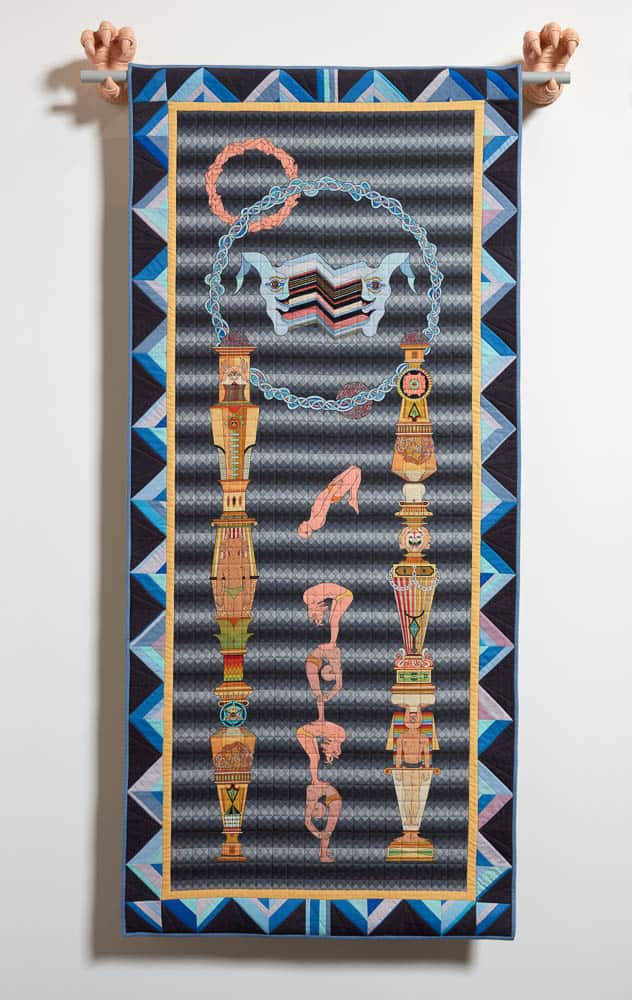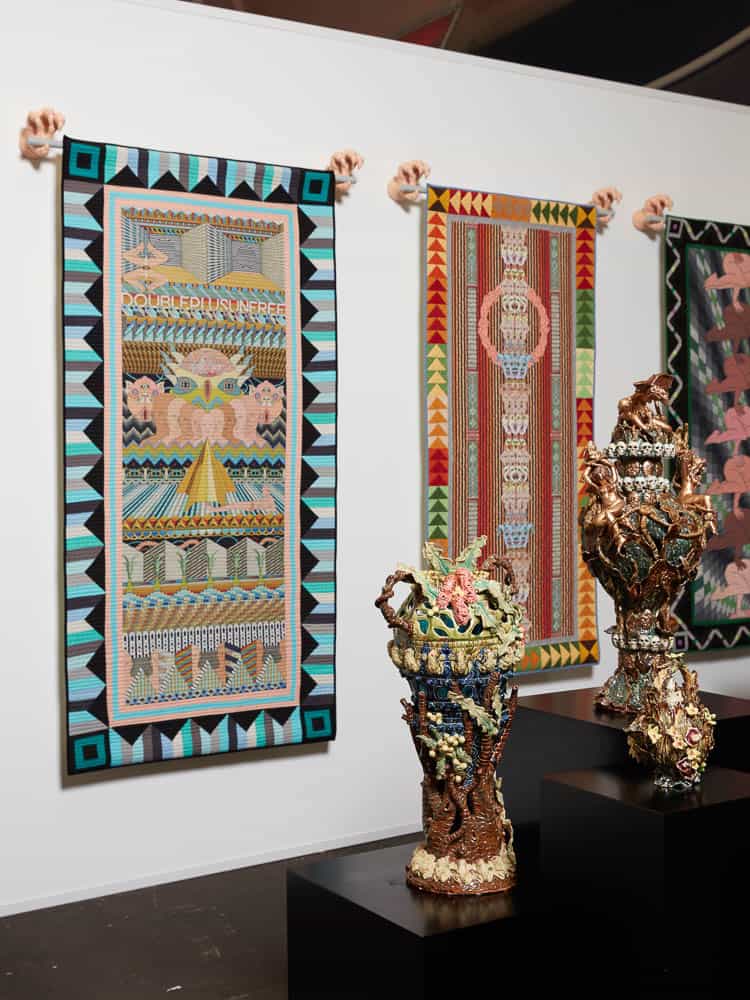- photo: Sam Hartnett
- Alien Flame Stakker, 2018 Jess Johnson & Cynthia Johnson Quilt made from digital print on cotton with pieced fabric border, assorted textiles, thread 89 x 190.5cm / 35 by 75 inches, photo: Sam Hartnett
- Double Plus Scroller, 2018 Jess Johnson & Cynthia Johnson Quilt made from digital print on cotton with pieced fabric border, assorted textiles, thread 103 x 205cm / 40.5 x 81 inches, photo: Sam Hartnett
- Wurm Scale Staff, 2018 Jess Johnson & Cynthia Johnson Quilt made from digital print on cotton with pieced fabric border, assorted textiles, thread 86.5 x 190.5cm / 34 by 75 inches, photo: Sam Hartnett
- Eclectrc Panoptic Stakker, 2018 Jess Johnson & Cynthia Johnson Quilt made from digital print on cotton with pieced fabric border, assorted textiles, thread 86.5 x 190.5cm / 33 by 74 inches, photo: Sam Hartnett
- Flesh Totem Double Arches, 2018 Jess Johnson & Cynthia Johnson Quilt made from digital print on cotton with pieced fabric border, assorted textiles, thread 89 x 198cm / 35 by 78 inches, photo: Sam Hartnett
- Galactic Gilgamesh, 2018 Jess Johnson & Cynthia Johnson Quilt made from digital print on cotton with pieced fabric border, assorted textiles, thread 81 x 183cm / 32 by 72 inches, photo: Sam Hartnett
- photo: Sam Hartnett
Jess Johnson is a New-Zealand born artist, currently based in New York. Her practice is influenced by the speculative intersection between language, science fiction, culture, technology and simulation. Working predominantly in drawings and installation, her recent video collaborations with Simon Ward have seen her drawings translated into a virtual realm. For the Auckland Art Fair 2018, Johnson presented a new body of work made in collaboration with her mother Cynthia Johnson, a quilt maker. The resulting works were pieced hand-made quilts featuring digital prints of Jess’s drawings. They signalled a new direction for the artist’s practice.
SC: This is the first time that you have collaborated. Can you talk about how this came to be? Was it something you had planned to do for a long time?
JJ: It came about through a shift that occurred both physically and mentally. After I moved to New York in early 2016 I was getting asked to be in exhibitions back in Australia and New Zealand but wasn’t able to travel to every invitation. My previous installations involved a high degree of manual labour that I would do myself. But being based in New York meant I had to develop ways to participate remotely. I got asked to be in MONA FOMA in Tasmania and was given this loose brief to do a project in a Masonic Hall. I’ve always been fascinated by the Freemasons and couldn’t turn it down. But the challenge was how to scale up my artwork to suit the huge dimensions of this hall and also get the work made in a way that didn’t require my labour. I ended up collaborating with sound composer Andrew Clarke, who created this dark atmospheric soundpiece (called Chondrule Terminus). My contribution was designing these giant theatrical banners that hung from the ceiling. It was the first time I’d ventured into getting my artwork digitally printed and it opened up all these new possibilities of printing onto fabrics and working with textiles. And I already had a quilt maker in my family so naturally, I started considering quilts.
My Mum is an accomplished quilt-maker. Every household in our family has a pile of quilts she has made for us (each quilt takes several months to complete). She always had a work area in the home while I was growing up where she would be hand dying, cutting, arranging and piecing material. I think this patterning and process really sunk into my own art-making, which you can see in the repetitive geometries, elaborate borders and use of templates in my drawings. Embarrassingly, I had never really acknowledged the influence of her quilt making before. I hadn’t exactly been dismissive of Mum’s quilt-making, but I had been guilty of relegating it to somewhere in the background. When I actually started looking with freshly opened eyes the parallels were really obvious.
The actual collaborative process with Mum involved me creating new compositions by cannibalising and rearranging elements from past drawings in Photoshop. I then printed these compositions onto quilter’s cotton and sent the bolts of cloth from New York to New Zealand. Mum then started turning these into quilts and creating the borders for each one.
SC: Jess, you often work with collaborators to realise your artistic projects. In recent years, your work has been translated into video and immersive installations in collaboration with Simon Ward and Andrew Clark. How was it different to see your work realised in a textile medium, instead of a digital one?
JJ: Working in a traditional textile medium was quite a departure from the tech-heavy, virtual reality collaborations with Simon Ward that I’m mainly known for. However, the digital artworks are premised on my drawings, which are entirely done by hand. I share this affinity to making things by hand with Mum. The drawings are the only time I get to physically touch and shape my work before it is coded into the digital realm. The act of drawing is something I hold onto almost desperately. It’s like I’m aware that I can easily be written out of the equation and my work could be created entirely on a computer. And Mum could use a computer to design her quilts as well. But then what would we both do all day? We’d be obsolete. So making our work by hand is as much for ourselves as it is for what we eventually make.
We both had a few jitters going into the fair as we were unsure of what the reaction to the quilts would be. There’s still a lot of entrenched patriarchal and hierarchical attitudes towards respecting quilts as an art form. And even though we felt strongly about them we knew it was a really new direction that people may not embrace. But happily for us, the response was overwhelmingly positive. I put a pic of the quilts on Instagram the week before the Art Fair and got the biggest response I’d ever gotten to a post…2,000 likes and 140 comments! Mum was glued to her phone. It was really affirming seeing all the textile artists and quilt lovers and Mums come out of the woodwork and give us a fist bump.
SC: Cynthia, I am interested to hear about your process of making and fabrication. How were the designs selected for the quilts? Did you have a template you were working from?
CJ: The experience of collaborating with my daughter, Jessica, was at first an intriguing concept but eventually became one of the most enjoyable experiences in my life as a quiltmaker. In her work, Jessica uses many of the geometric shapes that are found within both worlds of graphic art and quiltmaking. I was able to use these basic shapes of triangles, rectangles and squares to frame her artworks. I am rather “old school” in my work process so used graph paper and pencil to hash out various designs until I was happy.
Then came the hard part. I have never designed my quilts with a specific positioning of colour. Jessica’s centre design is placed up on my felt design wall (which fabric easily adheres to) and I would throw up pieces of fabric next to it until I saw the colours that worked together. I think that has been the tradition of quiltmaking since the nineteenth century where women would create six-foot large pieces of abstract compositions out of bits of fabric using their sense of design. Many of these quilts can be seen as forerunners to much of what is seen as abstract art of the twentieth century. Those who are interested just need to look up Gee Bend Quilts and the marvellous Amish quilts to see what I am talking about. Very little was seen by the general public because quilts were deemed as domestic work by uneducated women!
SC: There is an interesting correlation between the processes of quilt making, which is so much about precision and measurement, with the complexity and architectural mode of Jess’ drawings. Does the “building block” nature of quilt making and piecing add something new to the interpretation of the works? Was there anything unexpected that resulted from this process?
CJ: This is a good question. You must remember that Jessica grew up in a household where she saw her mother constantly creating quilts. She never evidenced any interest in sewing but was surrounded by quilts and the piecework of designs in construction. Her work from the age of two was often geometric in nature, perhaps reflecting the shapes I commonly used. Is it nature or nurture that encouraged this predisposition in her artwork? It is an old question that can only be speculated at. When Jessica proposed this collaboration I knew that it would be a fit. Her architectural designs use a similar visual vocabulary of basic composite shapes so it was not difficult to make her works into quilts by repetition of these same elementary blocks.
More importantly though was that Jessica knew from an early age that quilts can be objects of art and she wanted to honour that. As I child, she had been dragged along to many quilt shows. In fact, she would have gone to many more quilt shows than art galleries as there weren’t any art galleries where we lived. So she was used to looking at the quilts as artworks, even though the contemporary art world didn’t consider them as such. She came to understand just how arrestingly graphic quilts are and has come to acknowledge the impact quilts had on her own sense of composition and approach. That is why it has been such a natural fit for her to use the quilt medium in her artworks.
SC: The resulting quilts were displayed at the Auckland Art Fair in a similar fashion to wall hangings, with custom-created wall hooks fashioned like (talons?). Was it a conscious decision to display them in a similar way to paintings or drawings in a gallery? How did audience members react to the work?
JJ: The hanging system for the quilts was really important to me. I knew I could push it in some way to make the presentation more sculptural. I wanted there to be some “oomph” behind the quilts–something in-your-face–definitely nothing meek or discrete. I mulled on it for a long while until I came across this small family business in Illinois that produced these custom hanging systems for sword collectors. One of their products were these intricately sculpted Gothic-style dragon talons cast in resin. I instantly knew I’d found what I’d been looking for. I ordered a bunch, bought them to New Zealand in a suitcase. Then hand painted them a flesh colour in my Dad’s shed in Whangarei. I felt a definite nervousness around using them although that isn’t uncommon in everything I do. I like pushing really close to the edge of ridiculousness and using dragon talons to hang quilts in the land of Lord of the Rings was getting pretty close to parody. But as soon as I’d installed the first one I felt a huge relief. They still made me laugh but achieved everything I had wanted them to.
SC: Will this be an ongoing collaboration? If so, what’s next?
Jess: I hope so. We were very motivated to keep going after the response at the Auckland Art Fair. We’d like to tweak the process a little moving forward. Mum wants to concentrate on working on just one or one major quilts at a time, as the workload for producing several to a deadline was a little too much. She would also prefer to work on them during the New Zealand winter, as opposed to losing her entire summer as she did in the production of the Auckland Art Fair quilts. I have an exhibition at Nanzuka Gallery in Japan next year so we’re aiming to have some new quilts for that.
Author
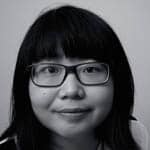 Sophia Cai is a Melbourne-based early-career curator and arts writer with a particular interest in Asian art history as well as contemporary craft. As an independent curator Sophia has worked on a number of projects and exhibitions, including Some words are just between us at Firstdraft in Sydney, Closing the Distance at Bundoora Homestead Art Centre, Slice of Life at Craft Victoria as part of the Emerging Curators Program 2017, and most recently Disobedient Daughters at Metro Arts in Brisbane. Her art writing has appeared in a number of online and print publications including Artist Profile, Art Almanac, Runway, un Extended and Peril Magazine. Sophia is currently the Public Programs Coordinator at the Australian Tapestry Workshop.
Sophia Cai is a Melbourne-based early-career curator and arts writer with a particular interest in Asian art history as well as contemporary craft. As an independent curator Sophia has worked on a number of projects and exhibitions, including Some words are just between us at Firstdraft in Sydney, Closing the Distance at Bundoora Homestead Art Centre, Slice of Life at Craft Victoria as part of the Emerging Curators Program 2017, and most recently Disobedient Daughters at Metro Arts in Brisbane. Her art writing has appeared in a number of online and print publications including Artist Profile, Art Almanac, Runway, un Extended and Peril Magazine. Sophia is currently the Public Programs Coordinator at the Australian Tapestry Workshop.

